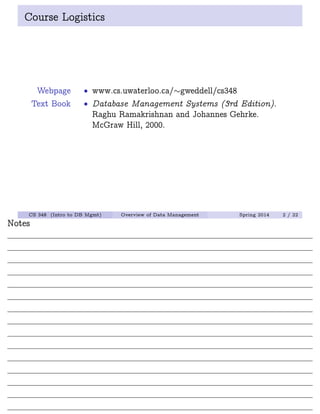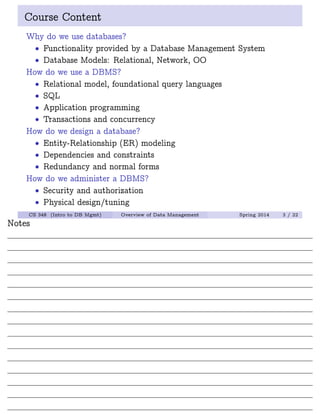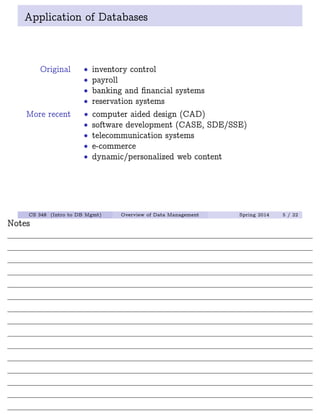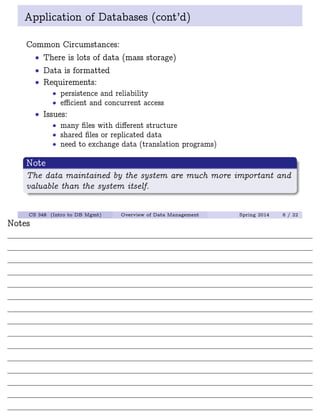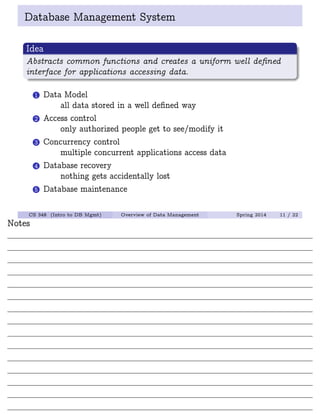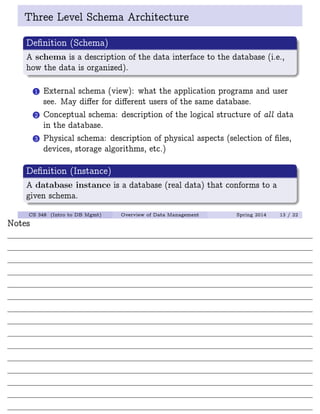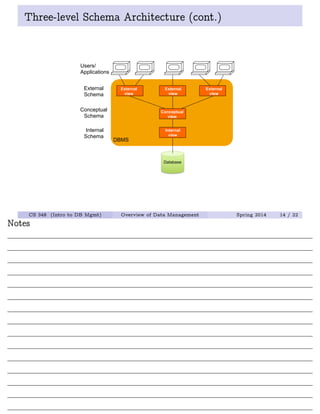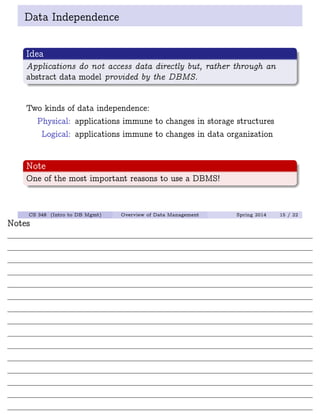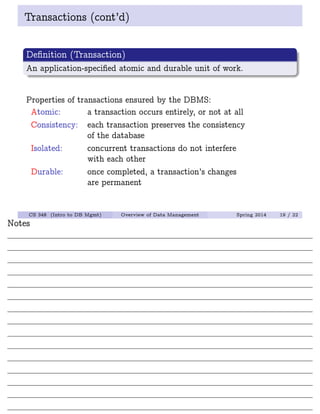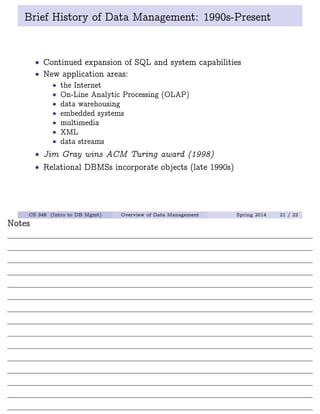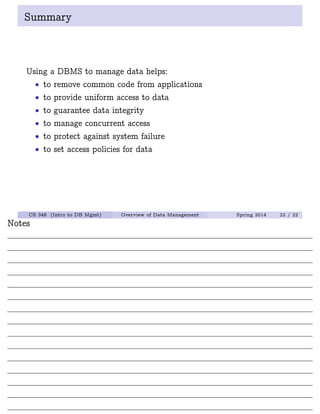1 overview-handout-notes
- 1. Overview of Data Management Grant Weddell David R. Cheriton School of Computer Science University of Waterloo CS 348 Introduction to Database Management Spring 2014 CS 348 (Intro to DB Mgmt) Overview of Data Management Spring 2014 1 / 22 Notes
- 2. Course Logistics Webpage âĒ www.cs.uwaterloo.ca/gweddell/cs348 Text Book âĒ Database Management Systems (3rd Edition). Raghu Ramakrishnan and Johannes Gehrke. McGraw Hill, 2000. CS 348 (Intro to DB Mgmt) Overview of Data Management Spring 2014 2 / 22 Notes
- 3. Course Content Why do we use databases? âĒ Functionality provided by a Database Management System âĒ Database Models: Relational, Network, OO How do we use a DBMS? âĒ Relational model, foundational query languages âĒ SQL âĒ Application programming âĒ Transactions and concurrency How do we design a database? âĒ Entity-Relationship (ER) modeling âĒ Dependencies and constraints âĒ Redundancy and normal forms How do we administer a DBMS? âĒ Security and authorization âĒ Physical design/tuning CS 348 (Intro to DB Mgmt) Overview of Data Management Spring 2014 3 / 22 Notes
- 4. What is a Database? Definition (Database) A large and persistent collection of (more-or-less similar) pieces of information organized in a way that facilitates efficient retrieval and modification. Examples: âĒ a file cabinet âĒ a library system âĒ a personnel management system Definition (Database Management System (DBMS)) A program (or set of programs) that manages details related to storage and access for a database. CS 348 (Intro to DB Mgmt) Overview of Data Management Spring 2014 4 / 22 Notes
- 5. Application of Databases Original âĒ inventory control âĒ payroll âĒ banking and financial systems âĒ reservation systems More recent âĒ computer aided design (CAD) âĒ software development (CASE, SDE/SSE) âĒ telecommunication systems âĒ e-commerce âĒ dynamic/personalized web content CS 348 (Intro to DB Mgmt) Overview of Data Management Spring 2014 5 / 22 Notes
- 6. Application of Databases (contâd) Common Circumstances: âĒ There is lots of data (mass storage) âĒ Data is formatted âĒ Requirements: âĒ persistence and reliability âĒ efficient and concurrent access âĒ Issues: âĒ many files with different structure âĒ shared files or replicated data âĒ need to exchange data (translation programs) Note The data maintained by the system are much more important and valuable than the system itself. CS 348 (Intro to DB Mgmt) Overview of Data Management Spring 2014 6 / 22 Notes
- 7. Brief History of Data Management: Ancient 2000 BC: Sumerian Records 350 BC: Syllogisms (Aristotle) 296 BC: Library of Alexandria 1879: Modern Logic (Frege) 1884: U.S. Census (Hollerith) 1941: Model Theory (Tarski) CS 348 (Intro to DB Mgmt) Overview of Data Management Spring 2014 7 / 22 Notes
- 8. Brief History of Data Management: 1950s First generation 50âs and 60âs âĒ batch processing âĒ sequential files and tape âĒ input on punched cards Second generation (60âs) âĒ disk enabled random access files âĒ new access methods (ISAM, hash files) âĒ mostly batch with some interactivity âĒ independent applications with separate files âĒ growing applications base CS 348 (Intro to DB Mgmt) Overview of Data Management Spring 2014 8 / 22 Notes
- 9. Brief History of Data Management: 1960s (contâd) As the application base grows, we end up with âĒ many shared files âĒ a multitude of file structures âĒ a need to exchange data among applications This causes a variety of problems âĒ redundancy: multiple copies âĒ inconsistency: independent updates âĒ inaccuracy: concurrent updates âĒ incompatibility: multiple formats âĒ insecurity: proliferation âĒ inauditability: poor chain of responsibility âĒ inflexibility: changes are difficult to apply CS 348 (Intro to DB Mgmt) Overview of Data Management Spring 2014 9 / 22 Notes
- 10. Brief History of Data Management: 1960s (contâd) âĒ Hierarchical data model âĒ IBMâs Information Management System (IMS): concurrent access âĒ only allows 1:N parent-child relationships (i.e. a tree) âĒ hierarchy can be exploited for efficiency âĒ queries navigate up and down treesâone record at a time âĒ data access language embedded in business processing language âĒ difficult to express some queries âĒ Network data model âĒ Charles Bachmanâs Integrated Data Store (IDS) âĒ model standardized by Conference On DAta SYstems Languages (CODASYL) âĒ data organized as collections of sets of records âĒ separation of physical data representation from usersâ view of data âĒ pointers between records represent relationships âĒ set types encoded as lists âĒ queries navigate between recordsâstill one record at a time CS 348 (Intro to DB Mgmt) Overview of Data Management Spring 2014 10 / 22 Notes
- 11. Database Management System Idea Abstracts common functions and creates a uniform well defined interface for applications accessing data. 1 Data Model all data stored in a well defined way 2 Access control only authorized people get to see/modify it 3 Concurrency control multiple concurrent applications access data 4 Database recovery nothing gets accidentally lost 5 Database maintenance CS 348 (Intro to DB Mgmt) Overview of Data Management Spring 2014 11 / 22 Notes
- 12. Brief History of Data Management: 1970s âĒ Edgar Codd proposes relational data model (1970) âĒ firm mathematical foundation ! declarative queries âĒ Charles Bachman wins ACM Turing award (1973) âĒ âThe Programmer as Navigatorâ âĒ Peter Chen proposes E-R model (1976) âĒ Transaction concepts (Jim Gray and others) âĒ IBMâs System R and UC Berkeleyâs Ingres systems demonstrate feasibility of relational DBMS (late 1970s) CS 348 (Intro to DB Mgmt) Overview of Data Management Spring 2014 12 / 22 Notes
- 13. Three Level Schema Architecture Definition (Schema) A schema is a description of the data interface to the database (i.e., how the data is organized). 1 External schema (view): what the application programs and user see. May differ for different users of the same database. 2 Conceptual schema: description of the logical structure of all data in the database. 3 Physical schema: description of physical aspects (selection of files, devices, storage algorithms, etc.) Definition (Instance) A database instance is a database (real data) that conforms to a given schema. CS 348 (Intro to DB Mgmt) Overview of Data Management Spring 2014 13 / 22 Notes
- 14. Three-level Schema Architecture (cont.) External Schema Conceptual Schema Internal Schema Conceptual view Internal view External view External view External view Users/ Applications DBMS Database CS 348 (Intro to DB Mgmt) Overview of Data Management Spring 2014 14 / 22 Notes
- 15. Data Independence Idea Applications do not access data directly but, rather through an abstract data model provided by the DBMS. Two kinds of data independence: Physical: applications immune to changes in storage structures Logical: applications immune to changes in data organization Note One of the most important reasons to use a DBMS! CS 348 (Intro to DB Mgmt) Overview of Data Management Spring 2014 15 / 22 Notes
- 16. Interfacing to the DBMS Data Definition Language (DDL): for specifying schemas âĒ may have different DDLs for external schema, conceptual schema, internal schema âĒ information is stored in the data dictionary, or catalog Data Manipulation Language (DML): for specifying queries and updates âĒ navigational (procedural) âĒ non-navigational (declarative) CS 348 (Intro to DB Mgmt) Overview of Data Management Spring 2014 16 / 22 Notes
- 17. Types of Database Users End user: âĒ Accesses the database indirectly through forms or other query-generating applications, or âĒ Generates ad-hoc queries using the DML. Application developer: âĒ Designs and implements applications that access the database. Database administrator (DBA): âĒ Manages conceptual schema. âĒ Assists with application view integration. âĒ Monitors and tunes DBMS performance. âĒ Defines internal schema. âĒ Loads and reformats database. âĒ Is responsible for security and reliability. CS 348 (Intro to DB Mgmt) Overview of Data Management Spring 2014 17 / 22 Notes
- 18. Transactions When multiple applications access the same data, undesirable results occur. Example: withdraw(AC,1000) withdraw(AC,500) Bal := getbal(AC) Bal := getbal(AC) if (Bal1000) if (Bal500) give-money give-money setbal(AC,Bal-1000) setbal(AC,Bal-500) Idea Every application may think it is the sole application accessing the data. The DBMS should guarantee correct execution. CS 348 (Intro to DB Mgmt) Overview of Data Management Spring 2014 18 / 22 Notes
- 19. Transactions (contâd) Definition (Transaction) An application-specified atomic and durable unit of work. Properties of transactions ensured by the DBMS: Atomic: a transaction occurs entirely, or not at all Consistency: each transaction preserves the consistency of the database Isolated: concurrent transactions do not interfere with each other Durable: once completed, a transactionâs changes are permanent CS 348 (Intro to DB Mgmt) Overview of Data Management Spring 2014 19 / 22 Notes
- 20. Brief History of Data Management: 1980s âĒ Development of commercial relational technology âĒ IBM DB2, Oracle, Informix, Sybase âĒ Edgar Codd wins ACM Turing award (1981) âĒ SQL standardization efforts through ANSI and ISO âĒ Object-oriented DBMSs âĒ persistent objects âĒ object idâs, methods, inheritence âĒ navigational interface reminicent of hierarchical model CS 348 (Intro to DB Mgmt) Overview of Data Management Spring 2014 20 / 22 Notes
- 21. Brief History of Data Management: 1990s-Present âĒ Continued expansion of SQL and system capabilities âĒ New application areas: âĒ the Internet âĒ On-Line Analytic Processing (OLAP) âĒ data warehousing âĒ embedded systems âĒ multimedia âĒ XML âĒ data streams âĒ Jim Gray wins ACM Turing award (1998) âĒ Relational DBMSs incorporate objects (late 1990s) CS 348 (Intro to DB Mgmt) Overview of Data Management Spring 2014 21 / 22 Notes
- 22. Summary Using a DBMS to manage data helps: âĒ to remove common code from applications âĒ to provide uniform access to data âĒ to guarantee data integrity âĒ to manage concurrent access âĒ to protect against system failure âĒ to set access policies for data CS 348 (Intro to DB Mgmt) Overview of Data Management Spring 2014 22 / 22 Notes


